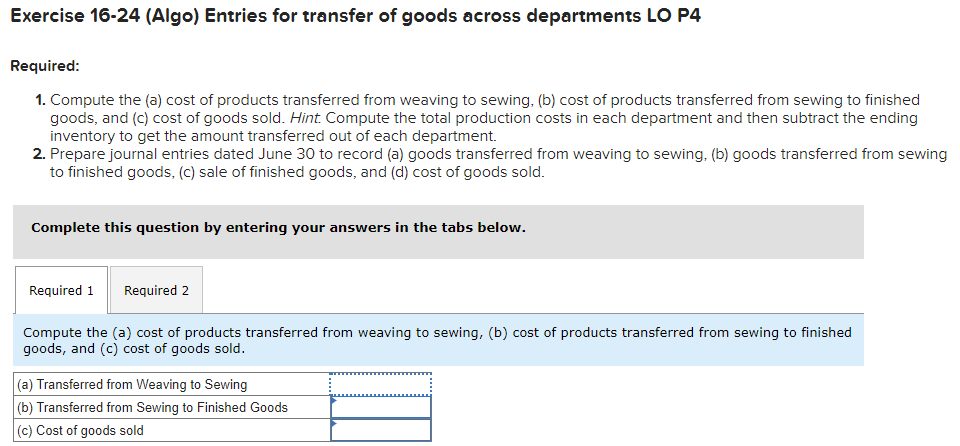Exercise 16-24 (Algo) Entries for transfer of goods across departments LO P4 Required: 1. Compute the (a) cost of products transferred from weaving to sewing, (b) cost of products transferred from sewing to finished goods, and (c) cost of goods sold. Hint. Compute the total production costs in each department and then subtract the ending inventory to get the amount transferred out of each department. 2. Prepare journal entries dated June 30 to record (a) goods transferred from weaving to sewing. (b) goods transferred from sewir to finished goods, (c) sale of finished goods, and (d) cost of goods sold. Complete this question by entering your answers in the tabs below. Required 1 Required 2 Compute the (a) cost of products transferred from weaving to sewing, (b) cost of products transferred from sewing to finished goods, and (c) cost of goods sold.
Exercise 16-24 (Algo) Entries for transfer of goods across departments LO P4 Required: 1. Compute the (a) cost of products transferred from weaving to sewing, (b) cost of products transferred from sewing to finished goods, and (c) cost of goods sold. Hint. Compute the total production costs in each department and then subtract the ending inventory to get the amount transferred out of each department. 2. Prepare journal entries dated June 30 to record (a) goods transferred from weaving to sewing. (b) goods transferred from sewir to finished goods, (c) sale of finished goods, and (d) cost of goods sold. Complete this question by entering your answers in the tabs below. Required 1 Required 2 Compute the (a) cost of products transferred from weaving to sewing, (b) cost of products transferred from sewing to finished goods, and (c) cost of goods sold.
Principles of Cost Accounting
17th Edition
ISBN:9781305087408
Author:Edward J. Vanderbeck, Maria R. Mitchell
Publisher:Edward J. Vanderbeck, Maria R. Mitchell
Chapter2: Accounting For Materials
Section: Chapter Questions
Problem 13P: Webster Company uses backflush costing to account for its manufacturing costs. The trigger points...
Related questions
Question
Please don't give image format and don't use chatgpt answer
![Required information
Use the following information for the Exercises below. (Algo)
[The following information applies to the questions displayed below.]
Pro-Weave manufactures stadium blankets by passing the products through a weaving department and then a sewing
department. The following information is available regarding its June inventories:
Ending Inventory
Raw materials inventory
Beginning
Inventory
$ 132,000
395,000
$ 241,000
Work in process inventory-Weaving
495,000
Work in process inventory-Sewing
655,000
945,000
Finished goods inventory
1,446,000
1,286,000
The following additional information describes the company's manufacturing activities for June:
Raw materials purchases (on credit)
Other actual overhead cost (paid in cash)
Materials used
Direct-Weaving
Direct-Sewing
Indirect
Labor used
Direct-Weaving
Direct-Sewing
Indirect
Overhead rates as a percent of direct labor.
Weaving
Sewing
Sales (on credit)
$ 650,000
186,000
$ 312,000
78,000
194,000
$ 1,375,000
515,000
1,600,000
85%
155%
$ 5,100,000](/v2/_next/image?url=https%3A%2F%2Fcontent.bartleby.com%2Fqna-images%2Fquestion%2F58f64e99-b3fb-491d-a9f5-7a66a1bd819c%2F2240abae-6096-4f24-8b1d-da481b014ff4%2Fiuuei8o_processed.png&w=3840&q=75)
Transcribed Image Text:Required information
Use the following information for the Exercises below. (Algo)
[The following information applies to the questions displayed below.]
Pro-Weave manufactures stadium blankets by passing the products through a weaving department and then a sewing
department. The following information is available regarding its June inventories:
Ending Inventory
Raw materials inventory
Beginning
Inventory
$ 132,000
395,000
$ 241,000
Work in process inventory-Weaving
495,000
Work in process inventory-Sewing
655,000
945,000
Finished goods inventory
1,446,000
1,286,000
The following additional information describes the company's manufacturing activities for June:
Raw materials purchases (on credit)
Other actual overhead cost (paid in cash)
Materials used
Direct-Weaving
Direct-Sewing
Indirect
Labor used
Direct-Weaving
Direct-Sewing
Indirect
Overhead rates as a percent of direct labor.
Weaving
Sewing
Sales (on credit)
$ 650,000
186,000
$ 312,000
78,000
194,000
$ 1,375,000
515,000
1,600,000
85%
155%
$ 5,100,000

Transcribed Image Text:Exercise 16-24 (Algo) Entries for transfer of goods across departments LO P4
Required:
1. Compute the (a) cost of products transferred from weaving to sewing, (b) cost of products transferred from sewing to finished
goods, and (c) cost of goods sold. Hint. Compute the total production costs in each department and then subtract the ending
inventory to get the amount transferred out of each department.
2. Prepare journal entries dated June 30 to record (a) goods transferred from weaving to sewing, (b) goods transferred from sewing
to finished goods, (c) sale of finished goods, and (d) cost of goods sold.
Complete this question by entering your answers in the tabs below.
Required 1 Required 2
Compute the (a) cost of products transferred from weaving to sewing, (b) cost of products transferred from sewing to finished
goods, and (c) cost of goods sold.
(a) Transferred from Weaving to Sewing
(b) Transferred from Sewing to Finished Goods
(c) Cost of goods sold
Expert Solution
This question has been solved!
Explore an expertly crafted, step-by-step solution for a thorough understanding of key concepts.
This is a popular solution!
Trending now
This is a popular solution!
Step by step
Solved in 4 steps

Knowledge Booster
Learn more about
Need a deep-dive on the concept behind this application? Look no further. Learn more about this topic, accounting and related others by exploring similar questions and additional content below.Recommended textbooks for you

Principles of Cost Accounting
Accounting
ISBN:
9781305087408
Author:
Edward J. Vanderbeck, Maria R. Mitchell
Publisher:
Cengage Learning

Principles of Accounting Volume 2
Accounting
ISBN:
9781947172609
Author:
OpenStax
Publisher:
OpenStax College

Principles of Cost Accounting
Accounting
ISBN:
9781305087408
Author:
Edward J. Vanderbeck, Maria R. Mitchell
Publisher:
Cengage Learning

Principles of Accounting Volume 2
Accounting
ISBN:
9781947172609
Author:
OpenStax
Publisher:
OpenStax College